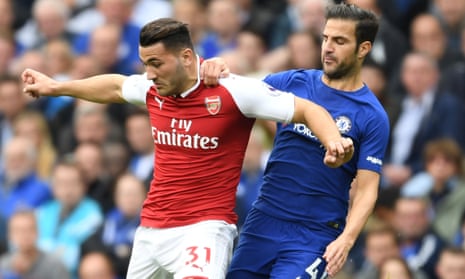One thing you often lose watching a football match on television is the sound levels. Not just the noise of the crowd but the noise of the players, a scale of collision and opposing force that means certain incidents, and indeed the careers of certain players, can have an entirely different register in the flesh.
David Luiz’s red card against Arsenal on Sunday was one such case. Replays and stills will show a raised foot but really this was a red card you had to hear. So profound was the thunk of contact those nearby knew instantly the challenge went beyond necessary force and into the realms of dangerous excess.
So, red, then. David Luiz does this kind of thing now and again. There has always been something zany about his bullocking runs, veering upfield like a dustcart on an icy incline, wheels spinning, horn parping, shearing off wing mirrors. Why he chose to do so here is perhaps more interesting.
Antonio Conte suggested his player had been riled by Alexis Sánchez nipping at him from behind. The player in front of David Luiz might also have had something to do with it. It may have been a coincidence Sead Kolasinac was looming into view as David Luiz set off on his full body lunge. But the fact is Kolasinac had been outmuscling Chelsea’s right side all afternoon, to the frustration of Chelsea’s players and the home crowd.
Several times Pedro simply bounced off Kolasinac in a sprint for the ball. Victor Moses, who can often overpower his direct opponent, had a poor game, unable to find space on that flank. Against Cologne on Thursday Kolasinac had spanked the equalising goal though Timo Horn with such force there was a burst of laughter mixed in with the celebration of some Arsenal fans. Here he did something similar, lifting his team simply through his controlled aggression and a basic sense of strength in reserve.
Not that anyone should be getting carried away here. It is a familiar Arsenal trope to fight hard for a creditable point after losing their past two away games but there is still something significant in Kolasinac’s presence in this team. If not as an indicator of future Wenger glories – it is, after all, getting late now – then as a glimpse of something that has been missing for too long, an echo of chances missed, opportunities passed, seasons congealed because of a lack, among other things, of just this quality.
Kolasinac is a fine player, a member of the Bundesliga team of the season last year. But he is above all a certain type, ambling about on legs that resemble industrial scale sacks of millet, great bulky elbows dangling at his side like a man carrying a pair of rolled-up carpets under his armpits, radiating not just power and willing, but a sense of cheerful optimism.
Fans have always loved players like this. There is nothing quite like seeing one of your own walk out at some distant, prickly away ground and immediately barge his way through the toughest player in the opposing team. More to the point this is Arsenal, who have not had a player like this to admire in some time. Not least at Chelsea, where these frail late-Wenger princelings have so often been jounced and bumped off the park.
When Wenger signed Kolasinac he suggested the Bosnian might be “the strongest” player he has ever worked with, praising his ability to use his power “without violence”, bumping opponents off without conceding a foul. It is tempting, as ever with the world’s most stubbornly one-note elite level manager, to wonder if there is some sort of willed amnesia in train here.
Instead Kolasinac represents something half-forgotten, a note of Wengerisms past, an echo of the powerful, hard-running players who characterised his best title-winning teams. Lauren, Ashley Cole, Nigel Winterburn and Lee Dixon were high-energy full-backs, a little nasty at times. Over time the Gilberto Silva, Patrick Vieira type steadily gave way to the dinky little Velcro-touch skill-gnomes of the stadium debt years, and after that to the non-specific midfield triers of recent years. But the best Wenger teams always had a notable physical power.
The last really imposing Arsenal midfield player was probably Abou Diaby, who was also famously frail. Alex Song was a good fit, allowed to leave too soon. Granit Xhaka was supposed to add drive and ballast. Danny Welbeck in full flight can be a domineering presence but it is the easy power of Kolasinac that Arsenal have lacked.
There was plenty of gristle in midfield at Chelsea. Both Cesc Fàbregas and N’Golo Kanté might have been Arsenal players had things fallen differently, minor cast members in the romantic comedy of Arsène’s fumbling almost-conquests. At Stamford Bridge they were pressed back before half time by Xhaka and Aaron Ramsey, who played as a genuine midfield pair, covering one another, not playing too flat or occupying the same space.
It would be over-egging it to suggest Kolasinac’s aggression had an effect here, a contagion spreading in from his flank, but he was a constant driving presence on the left side. To date he has had more touches per 90 minutes than any other full- or wing-back in the Premier League. He has more assists per 90 minutes than any other defender. Only Moses has made more fouls among defenders.
After the match Thierry Henry suggested Kolasinac should switch with Nacho Monreal and play deeper to harness better his exceptional one-on-one defending. But given the particular needs of late-Wenger Arsenal there is something hugely appealing about Kolasinac further upfield in this team, a stiffening effect, like a gust of warm air on a cold day.
There are probably two things worth taking from this. First, Chelsea will find other opponents pressing them hard. All four Chelsea red cards so far have come from the same kind of incident, a player overstretching into a tackle under pressure. This may be a coincidence. But it is also possible opponents are steeling themselves to press and rattle and harry Chelsea, to match that high-energy pressing game, as Burnley and Arsenal have.
For Arsenal it is far too early to interpret the spirit shown in the past two games as some kind of turning point. More likely Kolasinac’s fine form might just summon a note of regret, a sense of chances missed and seasons gone sour, that early-Wenger dynasty of strong technical football neglected in the mannered drift of the last few years.

